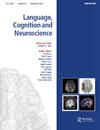ERP数据揭示的汉语复合词识别的时间过程
IF 1.8
3区 医学
Q2 AUDIOLOGY & SPEECH-LANGUAGE PATHOLOGY
引用次数: 0
摘要
本文章由计算机程序翻译,如有差异,请以英文原文为准。
Time course of Chinese compound word recognition as revealed by ERP data
ABSTRACT Previous studies have yielded conflicting results regarding the onset of semantic processing in compound word recognition. This study examined the role of semantics in morphological processing using event-related potentials (ERP) recorded for Chinese compound targets primed by W+M+, W−M+, W−M− (W = whole-word semantics, M = morpheme meaning, + = congruent, and − = incongruent), semantically related and unrelated primes. Two experiments were conducted. In Experiment 1 of a masked priming lexical-decision task (SOA = 50 ms), EEG results demonstrated that the brain was sensitive to semantic information as early as between 100 and 250 ms. In Experiment 2 of an unmasked priming lexical-decision task (SOA = 200 ms), data confirmed early semantic access. The two EEG experiments also showed that the semantics of constituent morphemes may have little bearing on compound recognition. Overall, these results seem to converge with a form-and-meaning account of compound recognition.
求助全文
通过发布文献求助,成功后即可免费获取论文全文。
去求助
来源期刊

Language Cognition and Neuroscience
AUDIOLOGY & SPEECH-LANGUAGE PATHOLOGY-BEHAVIORAL SCIENCES
CiteScore
4.50
自引率
13.00%
发文量
70
期刊介绍:
Language, Cognition and Neuroscience (formerly titled Language and Cognitive Processes) publishes high-quality papers taking an interdisciplinary approach to the study of brain and language, and promotes studies that integrate cognitive theoretical accounts of language and its neural bases. We publish both high quality, theoretically-motivated cognitive behavioural studies of language function, and papers which integrate cognitive theoretical accounts of language with its neurobiological foundations.
The study of language function from a cognitive neuroscience perspective has attracted intensive research interest over the last 20 years, and the development of neuroscience methodologies has significantly broadened the empirical scope of all language research. Both hemodynamic imaging and electrophysiological approaches provide new perspectives on the representation and processing of language, and place important constraints on the development of theoretical accounts of language function and its neurobiological context.
 求助内容:
求助内容: 应助结果提醒方式:
应助结果提醒方式:


